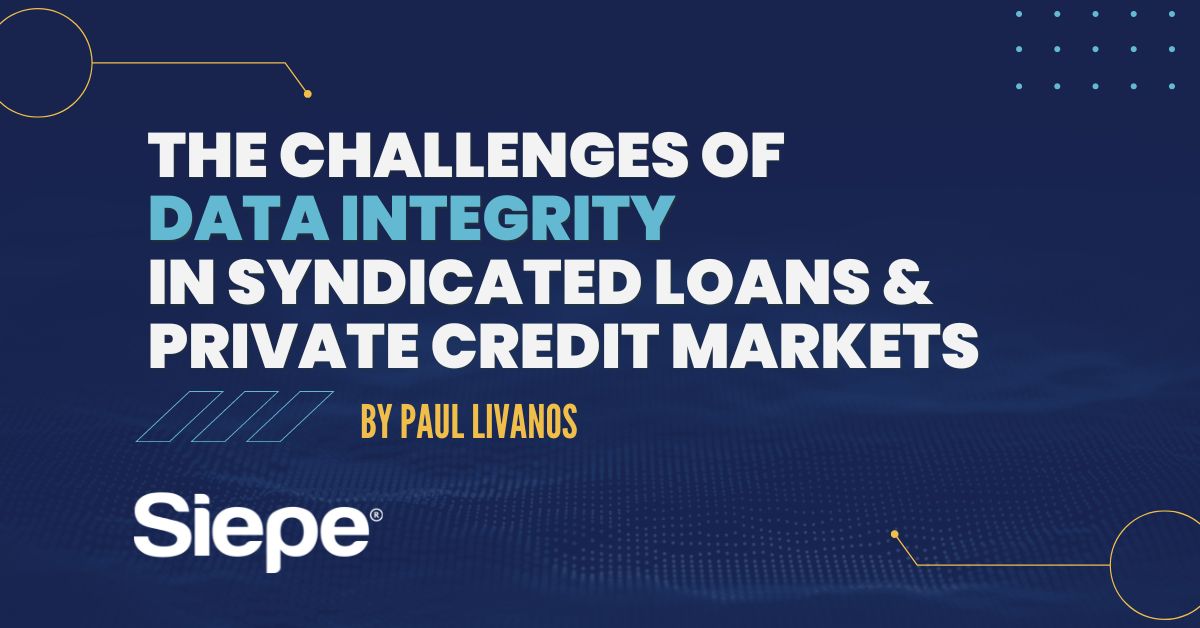When it comes to making strategic business and investment decisions, fund managers in the private credit and Collateralized Loan (CLO) space have always struggled with data integrity and accuracy. This is because there is no central database or single source of truth that’s fully transparent to all counterparties. For example, basic tasks from verifying holdings with agent banks to digitizing lender presentations and financial statements still elude a majority of non-bank lenders, making it difficult for the market to truly scale.
But to make matters worse, the continued disintermediation of banks has increased capital flows to the syndicated loan and private credit markets, causing them to grow exponentially – reaching over $2 trillion – which are already notorious for having less transparency throughout entire transaction lifecycles. This is placing further pressure on fund managers who are constantly managing expected cash activity and transactions across multiple systems with disparate data sources. Without having a way to effectively cleanse their data to make sure that it all clearly lines up, it becomes almost impossible for managers to carry out any investment activity that meets their objectives.
While there has been incremental technological change to improve the state of the Loan market since the late-80s and 90s, nothing has been done to completely modernize and overhaul how the market operates. It is still incredibly burdensome for many fund managers to pull data together more effectively and benefit from advanced analytics by slicing and dicing clean portfolio data.
So what can be done to improve access to clean and accurate data?
The issue of transparency in accessing clean, accurate data
Firstly, we need to take a look at why this issue is arising. If we take a look at the public credit space, credit and syndicated loans are originated by banks, but the data available is not always accessible. While the banks are the agents and are responsible for the ongoing administration of the loan, this information is only made available to lenders periodically.
On the flipside, funds in the private credit space act as the agents themselves but there are fewer lenders and the loans aren’t actively traded. As a result, fund managers will tend to use originate-to-hold strategies, which have knock-on effects: there is less liquidity; and limited access to information about the loan and the borrower.
At the same time, many funds don’t have the economies of scale to manage all their assets under management (AUM). There are many nuances between private loans and broadly syndicated loans, even if a fund manager has said, “a loan is a loan.” Private loans are highly negotiated and can differ from deal to deal, and lenders are able to work with the sponsors and the companies themselves to make amendments or restructure the debt if needed.
Operationally, managing the lifecycle of the asset class requires specific skill sets and technology platforms. Take broadly syndicated loans. These are widely held and traded on a secondary market, yet maintaining the security master data for these instruments and monitoring the activity remains a challenge. Those funds managing these loans will also often have diverse books that each have different reporting requirements, which make completing and maintaining the loan processing even more difficult.
Obtaining a single source of truth
Any fund manager entering the credit or CLO space (or even just trying to scale their business), needs to have the right people, processes and technology to filter their available data to obtain the single golden copy and trust that it’s accurate. This requires implementing a data management system that can clean and reconcile data by aggregating and normalizing it. By doing so, fund managers will be not only able to see the outliers but also pull in data from different market sources, internal platforms and third-party administrators.
Fortunately, technology exists to help automate the process by stitching together public and proprietary information so that managers can see the status of each asset and what has been received. Credit managers can then run queries across holdings to view characteristics, such as instrument level ratings or sector side-by-side with financial metrics such as EBITDA, senior leverage or loan-to-value. This lets a fund manager understand exactly what exposures they have to a borrower and company they might own loan tranches while ensuring it is validated, confirmed and consistent.
Additionally, it is common for credit managers to have to reconcile three or more sets of security master data with their various counterparties for data points that are static and found in the credit agreement, such as spread, maturity date, and an amortization schedule. This is because each party separately builds their own security master data, and often at times, these don’t match. Without using a data management platform, it becomes cumbersome to look through each data point of each source to identify where any mismatch has occurred. And even when a mismatch is found, fund managers will need to focus their time on the exception and do the research to determine the accurate values and data points they should be using. This process is lengthy and inefficient and could still be subject to human error.
If fund managers are still worried that there are multiple data sets, each pointing to different conclusions, how can they knowingly trust it to make important investment decisions? Getting the data right makes everything downstream that much easier. Fund managers will know their available cash balances, position sizes, and attributes at the instrument level so that data can be aggregated up to the fund level. As a result, fund managers will be able to optimize their portfolios by building par and trading into higher-quality credits.
Contact us today to learn more about our bespoke technology and how we’re helping firms of all sizes make faster, better investment decisions.

